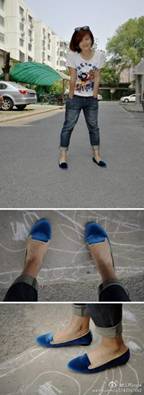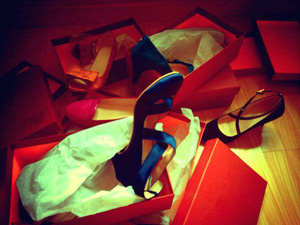Queque spreads her wings
- By Elsbeth van Paridon
 0 Comment(s)
0 Comment(s) Print
Print E-mail China.org.cn, July 11, 2012
E-mail China.org.cn, July 11, 2012
There’s no question that the social media universe has had a major impact on fashion over the past five to ten years, but don’t be mislead, this piece has nada to do with that particular phenomenon. Instead, it is fully dedicated to a new bird on the shoe scene who has recently set up her own shop on Taobao: Introducing Yang Que and her brand Adorable Mode.
 |
|
Branding the logo. Copyright @Yang Que |
Queque: l’oiseau du bonheur
Yang is a Changsha-born girl, whose nickname, Queque, refers to a little bird. She, like moi, is a member of the 80后 generation or, to put it in a more prêt-a-porter fashion, one of those born after 1980 (after the introduction of the one-child-policy). As was the case for all of the designers I have so far featured, Barbie had a big impact on the 11-year-old Yang and her dream of studying design, despite the fact that the world famous doll was not yet a household name in China. However, she influenced and inspired Yang every bit as much as Raf Simons’ first couture collection for Dior (which was a breath of fresh, structure-focused, back-to-basics air by the way). After practicing on her dolls for several years, and ruining their hairdos in the process, at that, she followed the dream and embarked on her journey to the world of the shabby chic, first in Shanghai and later in Paris. Unsurprisingly, Galliano is one of her principal hero-designers as he was responsible for many “powerful, independent yet feminine” designs for women. In the same vein, she also listed that other master of overtly sexually female fashion, the late Gianni Versace.
Et voila, c’est ca!
|
|
|
A luscious blend of color and texture. Copyright@Yang Que |
France, where fashion design translates as “stylisme”, sparked little birdie’s craving for a deeper knowledge about style design (the French always seem to have this influence on women; just think of Jackie O). Her education came both at school, where she majored in accessory design, and also in her daily life. She noticed how people seemed to have it down, how they managed to nail their look, have a personal style and didn’t look as though they were wearing Kloss sizes when they should be in Upton ones (I love both). Fashion design in China seems to be more about structural design, about the way you cut the clothes, about their volume, about their shape, focusing more on the clothing itself. In France however, Que learned how designs should also shine in style and detail; how the overall look should say “Et voila!” There should be a union between the outfit and its wearer (yes, some people do tend to look as though they get dressed in the dark).
SATC 3: Carrie goes China
No, the title does not refer to 1970s Carrie, but to the one of the early 2000s. Yang chose to design a shoe collection because, in her own words: “Hmpf, I am Carrie Bradshaw, I just love my shoes and I simply couldn’t find the ones I liked here in China, let alone at a decent price.” Her designs all share a simple lining, but are exquisite in their classic designs, fabric and execution. Women’s shoes in China originally were all designed for indoor activities and most of them are made of fabric. Women were meant to stay inside, in their designated quarters, whereas men went out (true on many levels as women literally had very few places to bop over to anyway on their bound feet). Other than that, Yang combines her Paris experience with inspiration from history or vintage pieces that carry a certain timeless beauty. She is also inspired by what she sees on people’s feet every day (which often gives you more of an idea of “what not to wear” if you ask me).
Mary Jane and Kim
When discussing “favorites”, the former refers to Yang’s favorite shoe and the latter to her favorite Chinese (men’s) shoe designer, Kim Kiroik from Shanghai. On the western front, she loves Louboutin for his femininity and the way he revolutionized ladies footwear. (Great sense of humor too that guy; I loved his recent quote “You have to suffer,” when referring to 9” heels. He’s right.) Yang doesn’t believe in a separation between the Chinese and Western fashion scenes and doesn’t necessarily like how some designers intentionally stitch Chinese elements into their designs (though she thinks the minorities here do this exquisitely). The one traditional Chinese element we can find in Yang’s shoes is the fabric she uses, such as silk. Understated lavishness, I say.
 |
|
Blue velvet. Mmmmm... Copyright@Yang |
Let them wear shoes!
In Yang’s palace of style, aesthetics are king. Her favorite shoe design was that of Versailles’ male, insert question mark, footwear which was worn during the 16th and 17th centuries. Louis XIV, a big fan of exorbitant fashion trends, and company took high-heeled shoes to the next plateau after the earlier, literal rise of the wooden or cork heel in Venetian fashion. (Legend has it Louis could rock a 5”one.) Yang wants her shoes, and future designs in general, to make her customers feel appealing and comfortable. Now, I’m not a bona fide ballerina type, but even I would love a pair of those velvet flats (that feeling on your toes...mmm...). Back on topic, Yang believes that Chinese designers do possess some A+ handicraft skills, derived from tradition, which are still useful for today’s demands, such as natural dyeing and the art of silk-crafting. I think it’s safe to say that if our little shoe bird continues to apply her skills in her collections, the shoes will give her a heel up and she will one day realize her dream of becoming China’s Marie Antoinette of accessory design!
Fashionistas United, promise me one thing:
“If you lose your feet and fall, keep strutting those Louboutins and don’t lose your nerve!”







Go to Forum >>0 Comment(s)